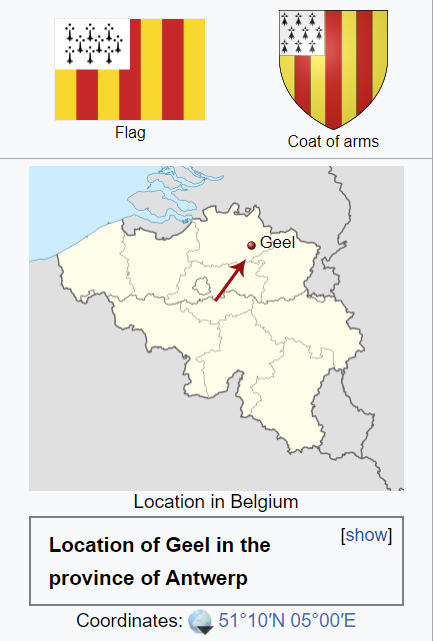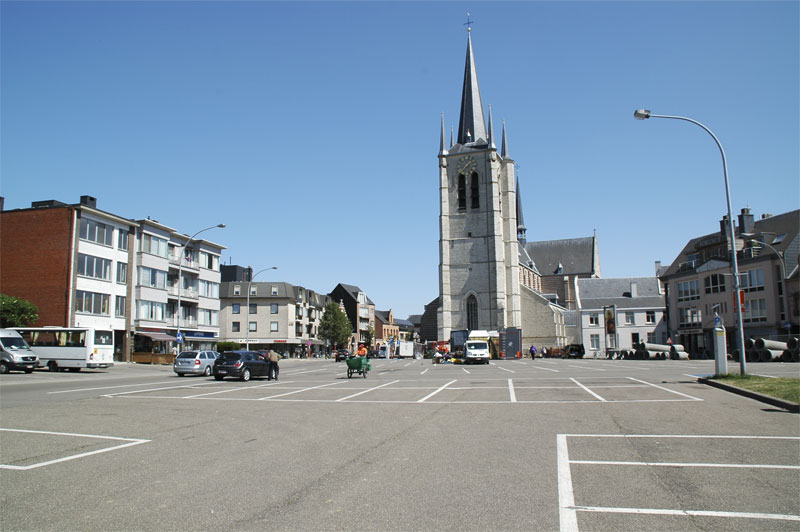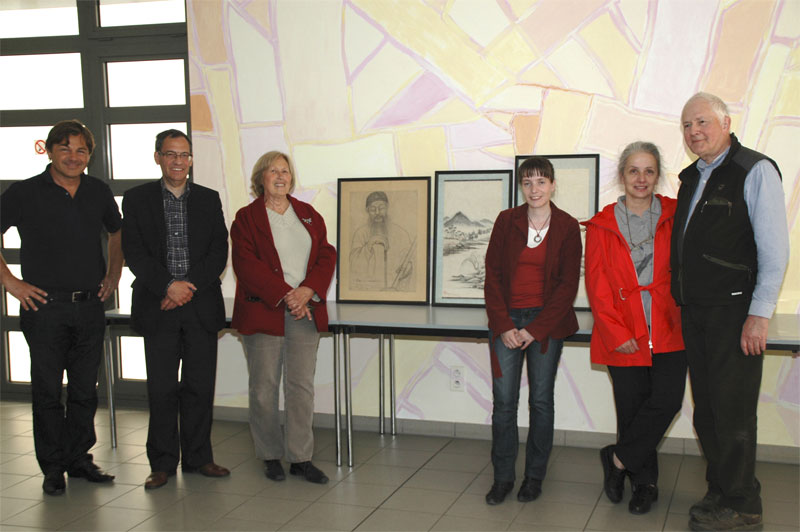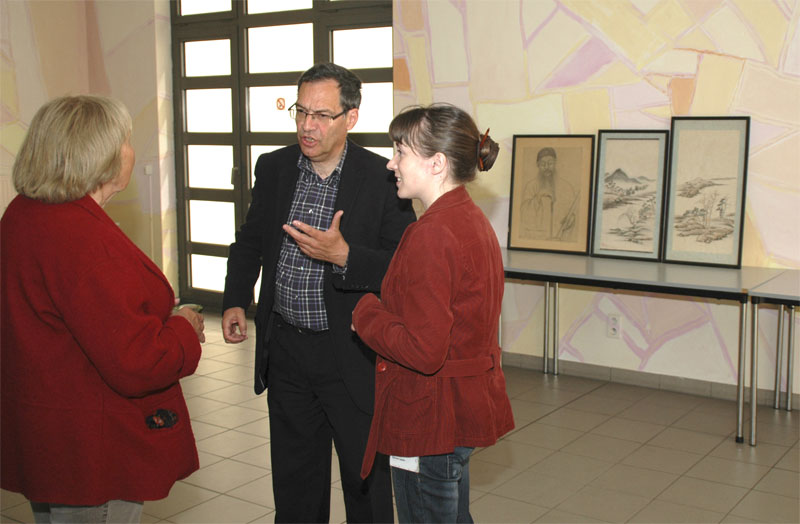Geel, province of Antwerp in Belgium.
We rendezvoused with Janette
at a supermarket parking just East of the battlefield where Napoleon’s
French army was defeated in June 1815. Waterloo. It was the mid-morning
of a beautiful sunny day and I set my GPS for a course bound for the
city of Geel — express highways excluded. We drove around the
Eastern-side of Brussels in the finishing morning traffic and then
turned right for Tervuren, Leuven, Aaarschot — and Geel. We
had a two hour ride through the pretty, very neat and clean Flemish
countryside. Nicky and Janette did a lot of woman gossip while I concentrated
on the GPS’s woman-voice instructions and driving the car safely
on. We arrived in Geel somewhere around noon. It was market day and
very animated with bicycles all over the place. We located the town
hall, a big and modern building not more that two stories high and
very well integrated in the green surroundings. The town hall buildings
were a few hundred yards away from a typical Flemish-style church.
We had lunch and walked around a bit. Just before two o’clock we went to meet Gonnie Leysen as scheduled by our numerous e-mail exchanges. She is the town of Geel’s archivist and very well informed about Father Van Genechten. She already had a few paintings to show to us in the office next door and the conversation started immediately. We excused ourselves for our bad knowledge of the Flemish language and as Gonnie’s knowledge of French wasn’t so good either we all spoke in English and later on we mixed all the three languages and everything was very comprehensible for all of us. Just then, Lorry Swerts arrived. He is THE Van Genechten specialist. He knew him personally when he was a young lad and admired Van Genechten a lot as a man and as an artist. Of course, I had with me, in my papers: the photo of Claude Giguère’s painting. I was quite certain that it was painted by Van Genechten but Lorry Swerts confirmed the contrary. Although the painting was the good style, it was not by Van Genechten. The signatures do not match and Lorry told us that in Van Genechten’s entourage, many other Chinese painters painted the same way. He thinks that the painter could be Luke Chen. Then we talked about George Wilder’s diary extracts. Unfortunately, no such sketches exist in Belgium. He has the sketch of a person smoking an opium pipe but that was not what we were looking for. Then, Lorry showed us two important documents … for our eyes only. They were yellow carbon copies, one of a document attesting that Edmond Van Genechten was a political prisoner imprisoned in Weihsien by the Japanese with signature and official stamp. I have the same kind of document in my personal papers and so has Janette. The second carbon copy was Van Genechten’s first letter home written in Flemish to his folks in Belgium just after the war. Lorry showed me the passages where he mentions Weihsien and the fact that our Japanese captors considered him as an artist and allowed him to sketch whoever he wished. The Japanese, he told us, had a great esteem for true artists and that is probably why Van Genechten was so free in his movements. Of course, all his sketches were confiscated by our guards and that is possibly why only two sketches have survived that period. Lorry told us that Mon Van Genechten regarded those two sketches of Weihsien as his personal treasures. In the same letter, Van Genechten tells us that after a few weeks in camp he was asked to give drawing lessons to adults. Our mother who always liked to draw and paint attended those classes in Weihsien and told us about it. Later on, in the 1950ies she did painting lessons by correspondence with a French school and painted quite a few oil paintings of us and many different landscapes as well. I know that Donald will be disappointed, but, IF the smoke-pipe-attitude-paintings still exist, they must be somewhere in Japan. Certainly not in China anymore. Everything was destroyed by the Red Guards during the Cultural Revolution. After that, Lorry and Gonnie guided us in the different offices and conference rooms of the Geel’s town hall. Van Genechten’s paintings are magnificently visible and Lorry has a long explanation for each one of them. What a fine artist he was! Lorry also told us how all those paintings came from China to Geel. Well … at the end of the 1940ies when many of us left China, Father Van Genechten came back to his homeland too. His most precious belongings were his paintings. He rolled them up together, into three big rolls. Upon arrival, at the end of the voyage, in Antwerp, he descended the ship’s gangplank with the three precious rolls and while doing so, he lost grip of one roll, which fell into the river Scheldt, … where it still is today! Janette asked Lorry, what “MON” stood for. “Mon” is diminutive of Edmondus, Van Genechten’s Christian name. He was known by his friends as “Mon” (or “Mond” for the French). Of course, I checked with Father Hanquet’s listings of all the Belgians in camp but did not find any “Mon”. I did find one Edmond but it was not Van Genechten. Lorry then showed us a quite a large room where the first "Van Genechten" exposition in 1994 was held. It was Mon Van Genechten's last wish to have his paintings shown in the cultural centre in Geel. . It was already over 4 o’clock, we had a drink and I was allowed to take a picture of the group. Our heads, buzzing with all the information we got in such a short time, we parted … very happy of such a nice afternoon in such good company. # The Flemish style church of Geel. --- from left to right: Kris Cuypers, director of the cultural centre, Lorry Swerts,author of the book: "Mon Van Genechten", Vlaming & Chinees kunstenaar, Janette Ley-Pander, Gonnie Leysen, the city of Geel's archivist, Nicky and Leopold Pander. Janette Ley-Pander, Lorry Swerts and Gonnie Leysen. |
|
--- a visit to the city of GEEL in Belgium, May 3rd, 2011 |




